How to Play "Cards of Wild"
Watch Demonstration Video!
Introduction
Cards of Wild is a two player online card battle game where two players battle each other with animal cards and environment cards. Both players shall be given a deck of cards, constructed of animals and plants from the World of Balance universe. Each player's deck shall also contain cards based on the environment where players control the elements by making it rain, causing a fire, or freezing everything. The players shall be represented by their own Tree of Life which has a given amount of health. It is the player's objective to protect their own tree and to attack the opponent's tree. Whoever's tree is left standing is the winner. Summon animals into the playing field by using your animal cards, they can then be used to attack your opponents summoned animals or tree directly. Make your animals stronger by feeding them with a Food Card, or shift the momentum completely by causing an environmental effect. However, there are rules to how a player can use their cards.
Let's get started!
To understand the game it's important to understand how cards work and where everything is, so lets begin.
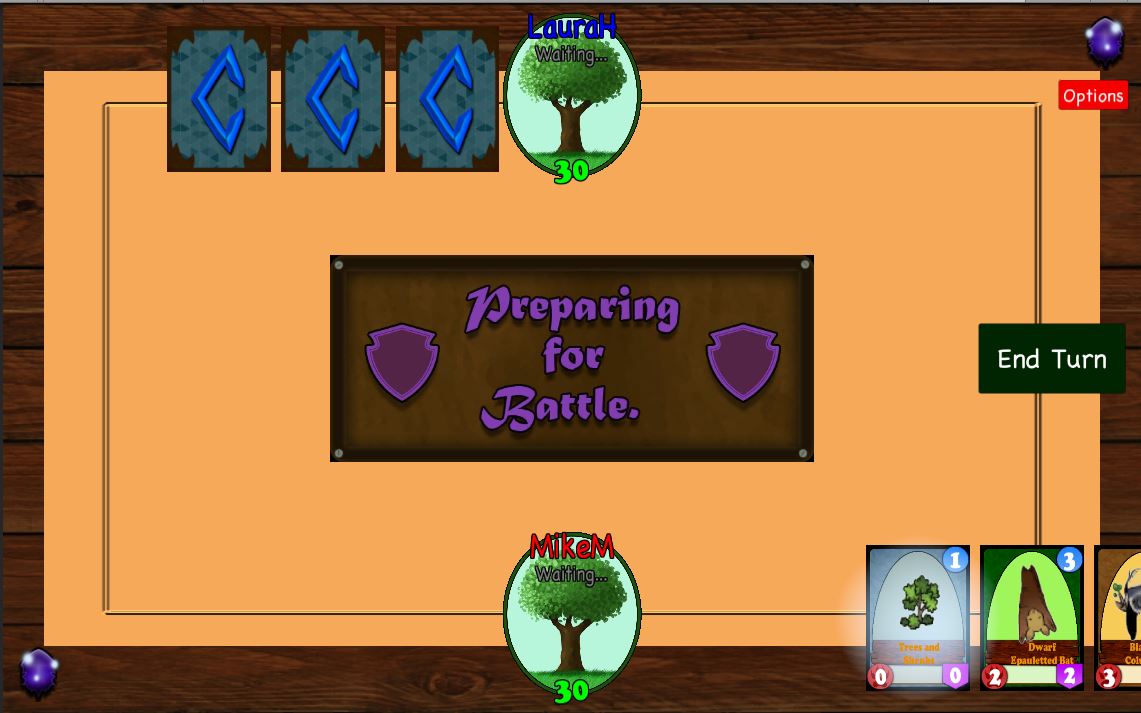 Loading a Game of Cards of Wild
Loading a Game of Cards of Wild
The Board, the Cards and Mana
Think of the screen as a board on a table directly in front of you. You have your deck and hand on your right hand side, your tree is you in the middle, and your mana is on your left.
Highlighted in the black box is the name and image of the card that varies from card to card. They can be either an animal, a plant, or an environmental effect. Each card type is played in different ways and have different strengths and weaknesses depending on the animal, plant or environmental effect.
Highlighted in the red box on the lower left corner of the card is the Attack Points of the card. The higher the Attacks points , the more damage the card causes on the cards in the field or tree directly. Opposite the Attack Points is the Health Points, highlighted by the purple box, on the lower right corner of the card. The more Health Points your card has, the more attacks it can sustain in the playing field when it's being attacked. Usually, if the card has a higher Mana Cost, the Attack and/or Health points are higher.
Wait, you can't just summon animals, plants or elements at your will. You need Mana in order to do so. In order to summon animals into the field, make the animals in the field stronger or summon the elements, you have to look at your Mana Cost, or Level, of the card. This is highlighted by the blue box on the upper right corner of the card. The number of Levels represents how much Mana has to be spent in a single turn in order to summon this card into the field or use this card.
Your Mana is represented by blue gems located to the left of your tree on the board. Think of Mana as you would money, you need money in order to "buy" animals or plants
from your hand and play them on the field. To think having a little money can manipulate the elements as well.
Only animals summoned onto the playing field can be used to attack the opponent's Tree of Life or the animals on your opponent's playing field. Also, only cards in your field
can be affected by your Food Card. However, be careful, when you summon your animals onto the field, the same applies to you, if your animals are in the field they can now be attacked.
One last thing, if you play a environment card, it affects both players.
Important: Summoned animals are able to start attacking on the NEXT TURN. No animal is allowed to attack on the same turn it's summoned!! Also, each animal already active on the field is only allowed to attack ONCE per turn!
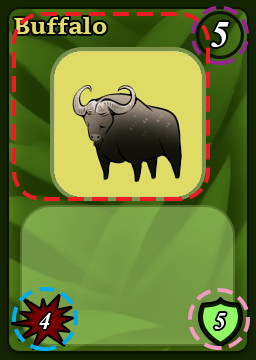 Explanation of a Card
Explanation of a Card
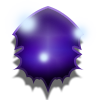 Example of the Mana Bar, 5 out of 9 mana
Example of the Mana Bar, 5 out of 9 mana
Card Types
There are two types of cards. Animal Cards and Utility Cards.
Animal Cards
The color of the animal card is very significant in the game - it represents the type of animal you are dealing with! Red cards are Carnivore cards, green cards are Herbivore cards, and brown cards are Omnivore cards. Different animal types have different targets that they can attack, which means that summoning the right type of animal at the right time is very essential!
- Carnivores: can only attack the opponent's animals on their field
- Herbivores: can only attack opponent's Tree of Life
- Omnivores: can attack both Tree of Life and animals on the field
The cards will have their own strengths and weaknesses based on the rules mentioned above. Herbivores and carnivores shall have fairly high attack points, but can only attack one type of target. Omnivores will have the advantage of attacking both animals and the Tree of Life, but as a cost for this trait, their attack points shall remain fairly low compared to herbivores and carnivores.
Utility Cards
Utility Cards, colored blue, have one of two effects, they can either affect a card or they can affect the board. Playing a utility card can alter the course of the game in your favor, or at your expense. Use them carefully.
There are two categories of Utility Cards
- Food: applies a buff of +1 Action Point and +1 Health Point on a summoned animal. A buff makes the summoned animal stronger.
- Environmental: applies an overall effect on the board, affecting BOTH players.
There are currently 3 environmental cards:
- Rain: gives BOTH players two food cards.
- Fire: clears the animals in the field. Fire essentially resets the game, all the summoned animals are cleared from the board.
- Freeze: puts all summoned animals in a "frozen" state, whereby they essentially can't be used on the next turn.
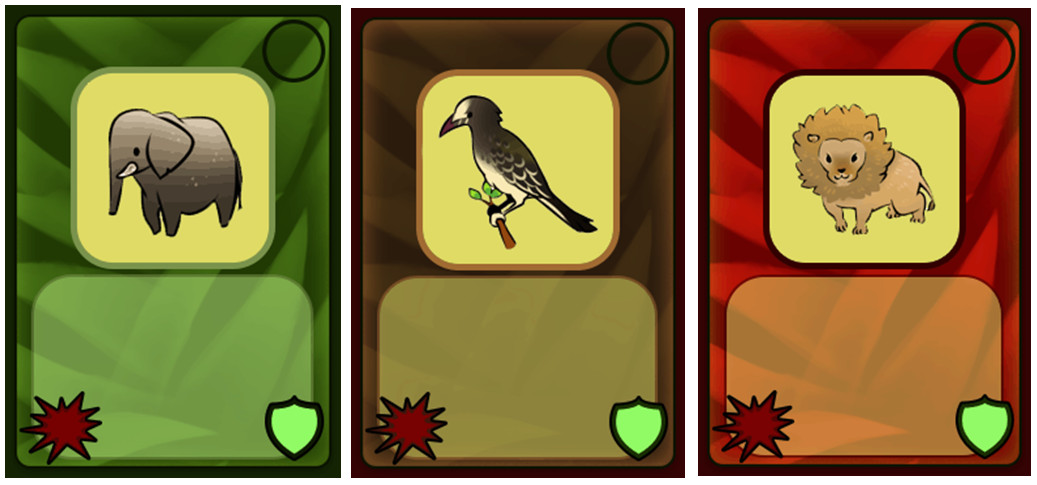 Animal Card Types
Animal Card Types
Game Setup
At the start of the Match, both players are given their individual Trees of Life and are automatically dealt 3 randomly selected cards from their deck into their hand - only the player can see the cards in their hand before they are summoned onto the playing field. Also, both players start the match with 1 Mana Point in their Mana Pool. Over the course of the game, the mana will be incremented, maxing out at 9. At the start of the player's turn, the player is given 1 additional Mana Point added to the current maximum and the Mana Pool is refilled. On the player's first turn they have 1 out of 1 mana, the second turn they have 2 out of 2 mana, on the third turn they have 3 out of 3 mana, and so forth. The players are also automatically dealt a card into their hand at the start of their turn. You can only have up to 5 cards in your hand and 6 animals in the field at any given point in the game. Players keep taking turns summoning animals, buffing their animals with food, or manipulating the elements with Environmental Cards while also attacking their opponent until only one tree is left standing.
How to Summon Animals
If the player has enough mana, they can summon an animal from their hand into the playing field, this is also indicated by a glow surrounding the card. To summon the animal, first click or tap(on a phone/tablet) on any card, this will bring the cards to the front and center view. Click or tap on the animal to be summoned in the front and center view and it will be summoned to the playing field. Every card cost mana, if a card can't be played, as in it can't be summoned, used or attacked with, they do not glow. Once you run out or do not have enough mana, your turn has ended and you should click or tap the button labeled "End Turn."
How to Use Food Cards
Food Cards are not summoned into the field. When you click or tap on a Food Card in the front and center view, you then have to pick a summoned animal to apply the food card to. As an effect the selected animal now has 1 more attack point and 1 more health point. In addition, that animal can continue to be fed adding more attack and health points.
How to Use Environmental Cards
Like Food Cards they are also not summoned into the field. When you click or tap on a Food Card in the front and center view, the effect is applied.
How to Attack
After successfully summoning an animal onto the field, on the next turn it can be used to attack by Clicking the card itself, and then Clicking the target you'd like the animal to attack. Note that the animal can only attack its proper targets based on its animal type (explained above). The damage dealt by each animal is determined by its Attack Points, which will be reduced from the target's Health Points (note: the attacking animal will consequently receive damage from the target's Attack Points to its own Health). If an animal's HP reaches 0, it dies and gets destroyed.
Strategy
A good strategy is to think whether it is more useful to summon
multiple low level or a single high level animal card on to your field on your turn! One can deal
a lot of damage, but multiple ones are harder to destroy at once...
Also, it's important to take into consideration the animals you are attacking with.
Are they going to get destroyed? Is it wiser to concentrate more on defending the animals in the field
or just proceeding to attack the opponent's Tree of Life? What's the best combination of animals that could
be summoned? How could the Mana be used in the most efficient way each turn (without wasting it)?
Consider when is it the best time to use a Food Card, should you buff up a low level summoned animal when you have no high level summoned animals,
so you can make it stronger and clear up space in your hand? Or should you save them for a high level card, so it becomes harder to destroy. However, remember you can only have up to 5 cards in your hand
and 7 animal in the field at any given point in the game. You or your opponent can also add 2 more food cards to your hand.
Rain Cards can be in your favor, at your expense or both. Think of the effect this will have on your game. Both players have 2 or more food cards
after using a Rain Card. Maybe your opponent has 3 high level cards in his/her hand and only has 3 Mana the next turn. Play your Rain Card and fill his/her hand
with 2 food cards, he/she will not draw a card the next turn, thus forcing him/her to essentially lose a turn. However, if your opponent has some summoned animals, he can now make them stronger.
Playing with fire can get you burned, when playing a Fire Card, consider what your opponent might have in his hand and also consider what your opponent has in the field. Is his field just filled with
a bunch of 1 Attack 1 Health Point animals? Maybe this isn't the best time to play the Fire Card.
Did your opponent just summon a 5 AP and 5 HP Herbivore and all you have are 2 cards with 1 Attack Point? You might want to freeze it, but consider every situation.
Possibly wait for his next play before using the freeze card.
Remember to attack with your summoned cards before using a Freeze Card, just like Fire, Ice also burns.
Everything being dealt is random, you or your opponent can start with 3 high level cards, or even 3 utility cards.
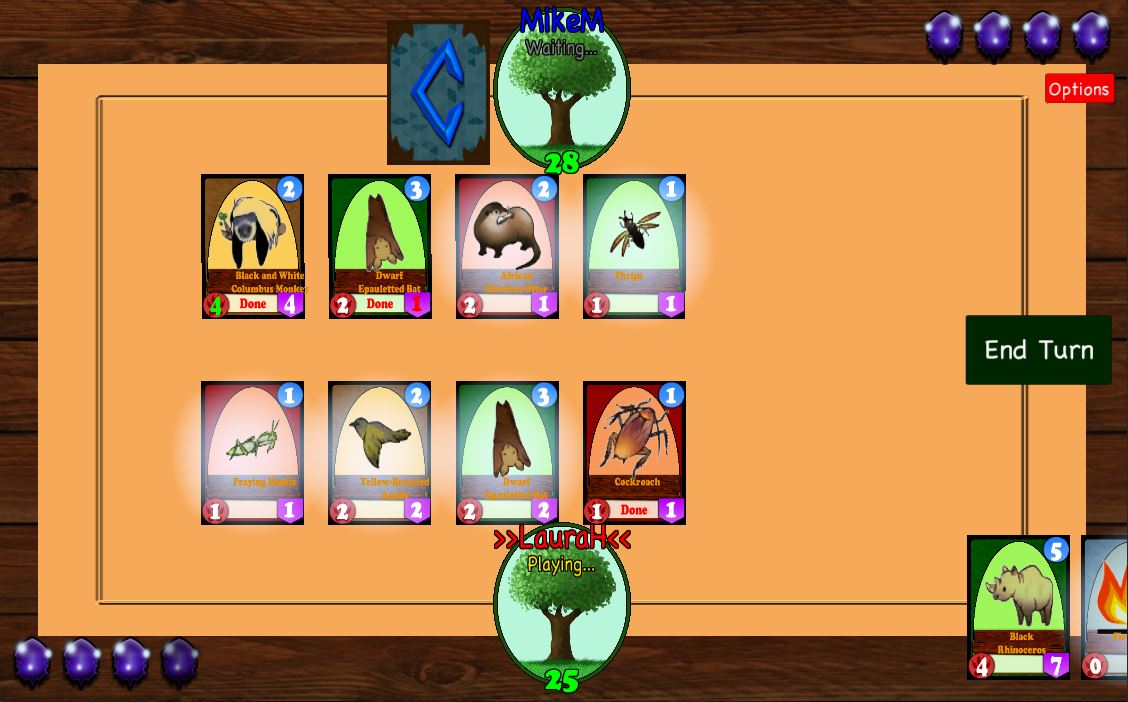 Example of Game Play
Example of Game Play
 Game Almost Over!
Game Almost Over!
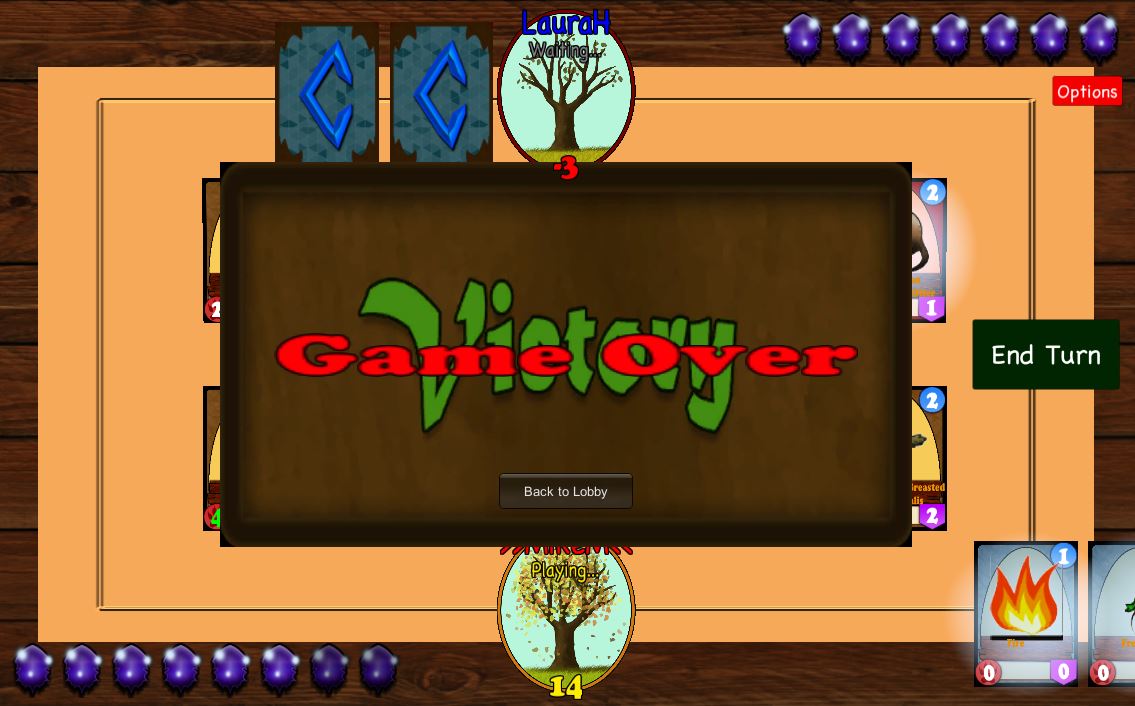 Game Over, Victory!
Game Over, Victory!
